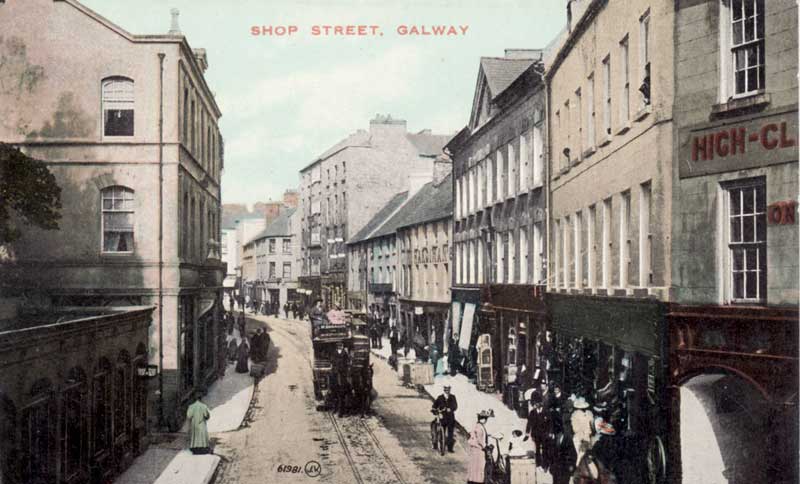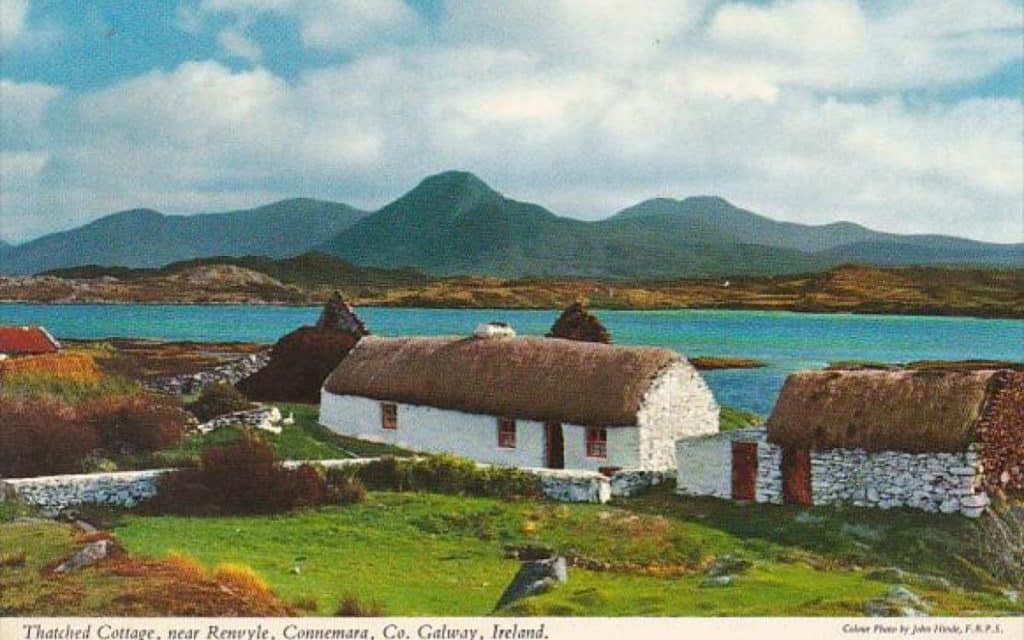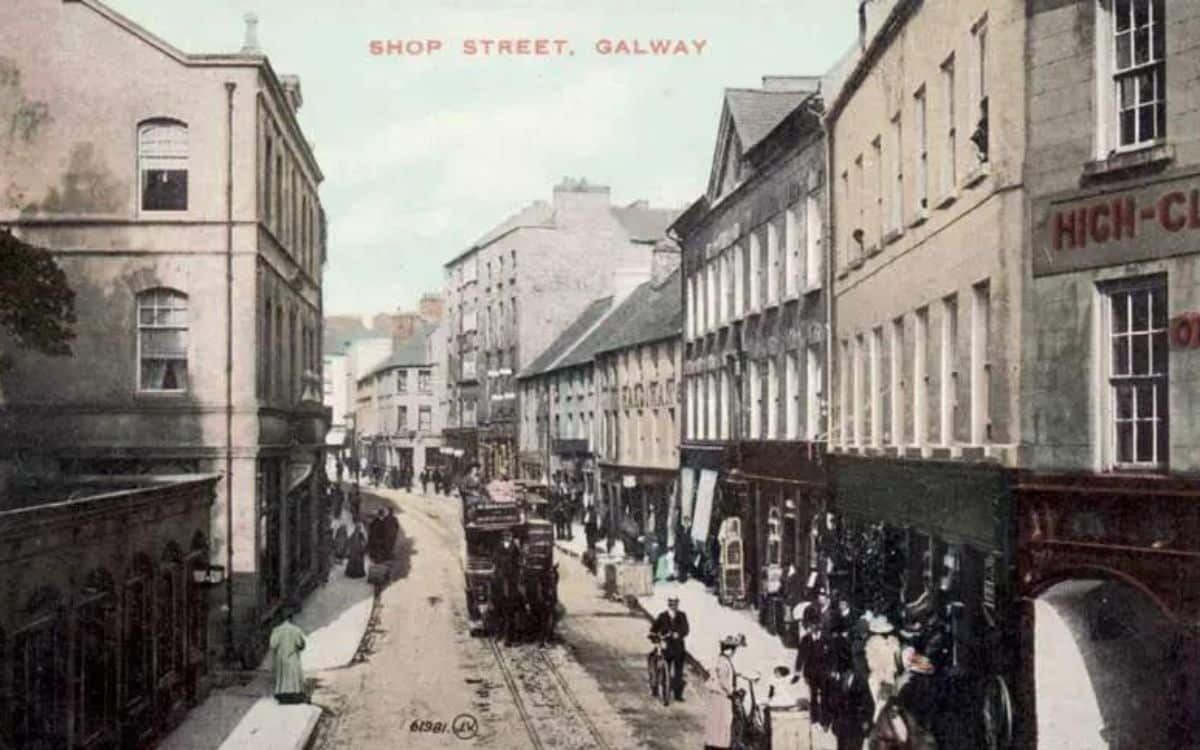PAUL MOYNIHAN looks at Ghoulish Galway, a Gateway To A Haunted Land!

Beautiful County Galway is situated in the wild west of the Emerald Isle.
Galway is a breathtaking juxtaposition of vibrant villages and a cultured, bustling city.
But beyond the romantic beauty of the jewel in Ireland’s crown lies a dark (and often disturbing) past.
Here, we will look at just some of the many terrifying locations that can be found in the weird but wonderful west. Welcome to Ghoulish County Galway.
Renvyle House Hotel, Connemara, County Galway
Situated in the stunning wilderness of Connemara, Renvyle House is one of Ireland’s most beautiful getaway destinations. Surrounded by breathtaking scenery, it’s picture perfect.
The tales of ghosts, ghouls and strange goings-on, however, show this most haunted hot spot in an altogether different light.
Renvyle was first opened as a country house in 1883 by the Blake Family.
Since then, the historic building has played host to many well known personalities, including Winston Churchill and W.B Yeats, the latter of whom spent his honeymoon there.
The house is supposedly haunted by many spirits. Various visitors to Renvyle have reported strange paranormal occurrences over the years.
In 1917, Oliver St. John Gogarty (a well known poet and surgeon from Dublin) purchased the house.
During his time as owner, his servants refused to stay in a certain upstairs room.
They claimed to feel a dark and disturbing presence in the room.
On one occasion, this strange entity supposedly pushed a large chest in front of the door, preventing access to the room.
It was not just Gogarty’s servants who experienced unexplained phenomena in the house.
The man himself also claimed to have come up against forces from another world.
Late one night, Gogarty was awoken by the sound of footsteps coming from the corridor outside his room.
He arose from his bed, lighting a candle to guide his way down the dark corridor.

All of a sudden, the flame was extinguished.
A tiredness fell upon Gogarty, which he could never fully explain.
It was during legendary Irish poet W.B Yeats‘ stay at Renvyle that activity reached an all-time high.
Yeats (a noted paranormal obsessive) held a seance in the house with his wife, the well known medium Georgie Yeats.
During this seance, Yeats used automatic writing to converse with the supposed spirit.
This being stated that it was unhappy with strangers staying in the house, but agreed to reveal its identity to Georgia.
The spirit, according to Georgie, revealed itself in the form of a vapourous mist standing beside the fireplace.
She described him as a red-haired boy, pale, with an anguished expression on his face.
W.B. himself also experienced strange phenomena during his time in Renvyle.
He claimed to have witnessed bed-sheets being pulled from beds, and guests being pulled from them also!
Yeats spoke of doors opening on their own, and the sounds of pitiful groans echoing throughout the house.
It is said by many guests that these ghosts have no respect for privacy: many women have witnessed faces looking at them in the mirror as they began to undress!
Perhaps this is the spirit of the man who strangled himself with his bare hands… who knows?
One thing is for certain: don’t be fooled by its beautiful, breathtaking surroundings. It seems some of the guests of Renvyle House Hotel never left…
Thoor Ballylee Castle, Gort, County Galway
Staying with the theme of W.B. Yeats, we move onto Thoor Ballylee Castle.
This remarkable building was once home to the famous poet, and has been surrounded by legend ever since.
Built in the 16th Century, the castle is situated near the town of Gort, close to the Galway-Ennis road.
The tower became part of the Coole Estate in 1902, falling into the hands of Yeats life-long friend, Lady Augusta Gregory.
The Irish Literary Revival occurred in Coole Park, part of the estate.
It was here that such literary geniuses as George Bernard Shaw and Yeats would meet to discuss their work.
Yeats fell in love with the area. He purchased the nearby tower in 1917 for the price of 35 pounds, and vowed to restore it for his love, Georgie.
The tower became the Yeats family summer home for more than a decade, mystifying the poet and completely bewitching him.
It was not long until Yeats belief in the paranormal began to manifest itself in the tower.
The poet was convinced that the tower was haunted by the ghost of an Anglo-Norman soldier.
This spirit was seen by others, apparently floating up and down the stairway of the tower, and the curator’s dog refused to venture into some rooms of the tower. Thoor Ballylee was sadly abandoned in 1929, falling into ruin.
The tower was re-opened in the summer of 1965, the centenary of the birth of Yeats, restored to its former glory.
The tower also housed first editions of Yeats’ work, and items he owned throughout his life. In 1989, the Blinkthorne family visited the tower for a tour.
David Blinkthorne entered what had been Yeats’ sitting room, and took a photograph. He and his family continued on their tour, and it was when David developed his photographs afterwards that he came across the most shocking of finds.
The photograph he had taken in the sitting room showed what appears to be a young boy standing in the room.
Many people who have studied this photograph believe that the spirit is Yeats’ son.
The ghostly apparition is now referred to as ‘The Blinkthorne Ghost’.
Druid Lane Theatre, Galway City
In 1979, a theatre group known as Druid moved into an abandoned building close to the well known Quay Street in one of the oldest parts of Galway City.
The building became known as Druid Lane Theatre, and since its inception, Druid have established one of the country’s finest theatres, hosting performances of all manner of plays to rapturous and rave reviews.
The location itself is full of history. Archaeological digs uncovered the foundations of Galway founder Richard de Burgo (the Red Earl)’s castle.
This adds to the mythos of Druid Lane Theatre, giving the place an air of majesty and wonder. However, as with all theatres worth their salt, there appears to be a resident ghost.
Many of the buildings along Druid Lane were convents and nunneries throughout the 1970s, and it is from here that our ghost enters the story.
Many people in surrounding businesses and houses claim to have witnessed the spectre of a nun walking down Druid Lane and the surrounding streets.
The spectre appears to be unaware of the attention she is drawing, perhaps lending to the theory that this is a residual haunting, a spirit stuck between her own realm and ours.
In the ’80s, the Irish actor Sean McGinley was working in the theatre late one night when he heard very strange sounds.
He decided to get out of the building rather than investigate, clearly unnerved by the incident. He and his fellow actors went on to produce and perform in many acclaimed plays…perhaps overlooked by the spectral nun of Druid Lane.
When not enjoying the culture of a good play, perhaps she enjoyed a stroll in the next area on our list…
The Long Walk, Galway City
Numerous landmarks and places of historical significance are scattered throughout the City of the Tribes, and one of its best known is The Long Walk.
Built as an extension of the vibrant city quays and situated near the well known Spanish Arch, The Long Walk has served as a favourite walking destination for three centuries.
Immortalized in song and works of art, an air of romanticism surrounds this well known area.
Stories of the strange and unexplained have also been told about this picturesque promenade, and many locals claim the place is a hotbed of hauntings.
Tales of a mysterious Lady In White being seen on The Long Walk, Wolfe Tone Bridge and the nearby village of Claddagh have been told for decades.
It was in early 2012, however, when the most mysterious event in The Long Walk’s history occurred.
A local photographer was taking photographs in the area when, to his amazement, he noticed the strange image of a female figure dressed in dark clothing standing in one of the shots.
The woman does not appear in any of the other shots, adding to the mystery.
Many people who have studied the photograph believe the apparition is that of a 19th Century nun from Claddagh.
The possibility of the image simply being a ‘Long Walker’ is unlikely, as the other photographs do not show the image. Who knows?
Perhaps the apparition is simply a camera malfunction, as has been debated.
One thing is for certain: it’s made a lot of people’s midnight strolls on The Long Walk come to an end, for fear of meeting the phantom face-to-face!
Woodlawn House, Kilconnell, County Galway
Many houses on the Emerald Isle have been bitten by the beast of abandonment; breathtakingly beautiful buildings that were once home to gentry and noblemen, places where the glory days are well and truly gone, left to rot and decay while the world around it grows and moves on.
Woodlawn House holds the mantle of being one of the best known abandoned houses in Ireland and, according to many (including top filmmakers from Hollywood) it may just be the country’s most haunted (and it’s only down the road from your’s truly!).
Situated on 115 acres of scenic land, Woodlawn House features 26 bedrooms, a gardener’s house, a gatehouse and its own lake. Interestingly, it holds 365 windows, one for every day of the year.
Woodlawn House was built in the late 1700s by the first Baron Ashtown, Frederick Trench.
The house stayed in the family until 1973, after which it was sold to a local farmer. The house has seen a number of other owners since then, and the present owner has begun to restore the building.
Rumours of a tragic suicide on the grounds of the house have led to countless tales of ghosts and ghouls in this macabre mansion.
When the makers of the hit horror movie ‘The Blair Witch Project‘ visited the house to film a documentary about Ireland’s most haunted houses, they said Woodlawn House was the scariest.
The house sits idle today, heavily guarded by numerous security cameras, and many trespassers hoping to catch a glimpse of the place have been stopped in their tracks by local police, adding to the mystery of the house.
Those lucky enough to get into the house (and it must be noted, I do not recommend approaching the house out of respect) claim to have experienced all manner of paranormal goings-on.
Would-be ghost hunters say they have heard the tormented wails of a girl in the house, the sound of phantom footsteps following them throughout the horrid hallways, and the presence of an otherworldly entity in the mysterious ‘hook room’.
Woodlawn House may lie derelict, unused and rotting in the grandeur of a lavish County Galway estate, but it serves as a link to Ireland’s past.
That link, it seems, may serve as a gateway to the other-side…
There you have it; Ireland’s West, it would appear, is a gathering of ghostly goings-on, a highlight in any haunt-seekers handbook, and a picture postcard snapshot of spooky spectres.
The City of the Tribes is alive with tales of the dead, and this is just a handful of supposedly haunted places the county has to offer.
Next time you venture West, don’t be fooled by its captivating beauty or its hypnotic scenery; keep your eyes peeled for the spirits that roam this land, for they are many…
Have you seen a ghost in County Galway? Tell us about it in the comment section below!




I love it.i wood love to go to woodlawn